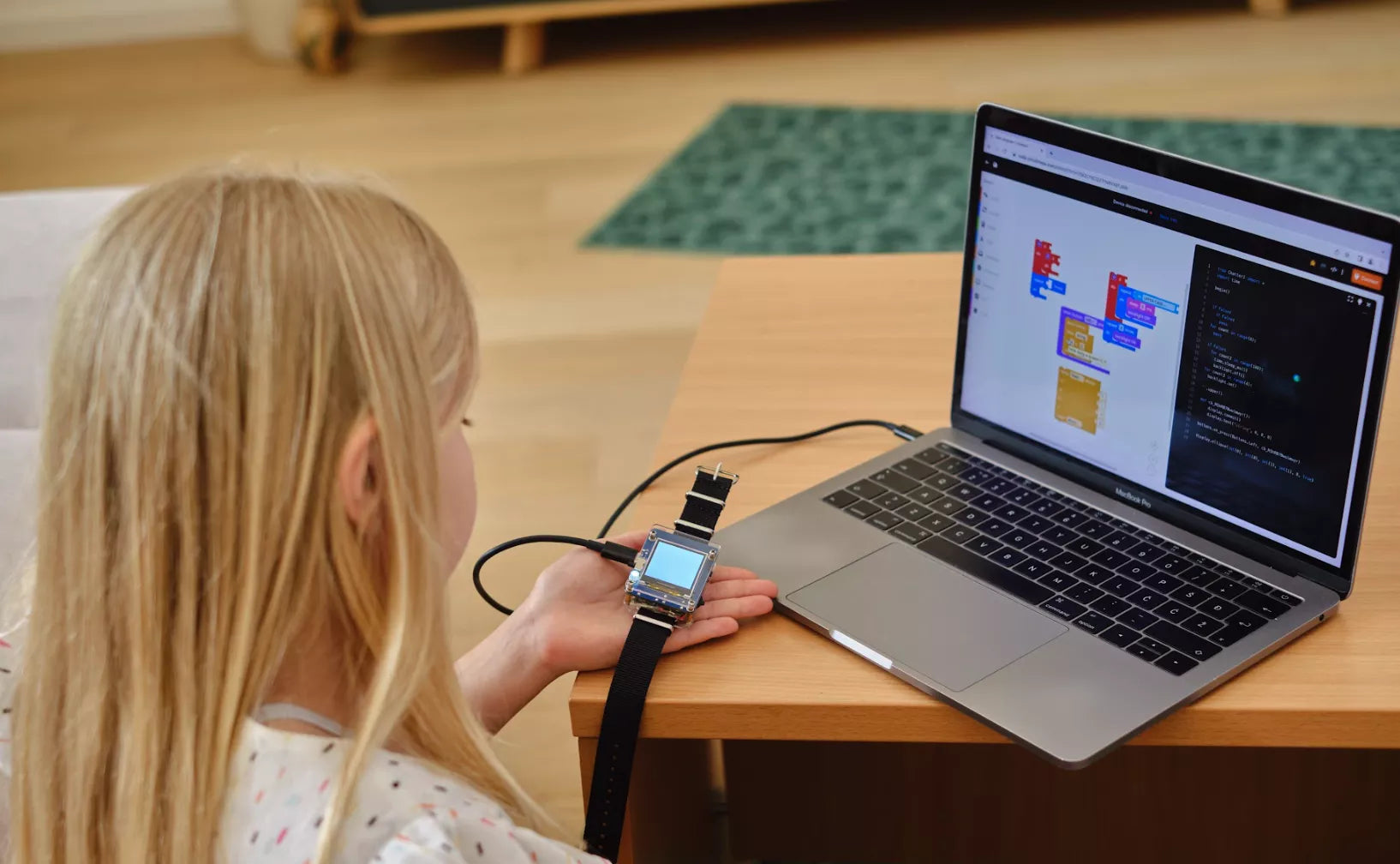
How to Introduce AI to Your Kids?
Read stories how our founder Albert turned his childhood passion into CircuitMess, and get exciting DIY project ideas you can do with your kids at home for free.
Table of content
You've heard of the phrase, you've interacted with this rapidly transforming technology—it's artificial intelligence (AI).
Although artificial intelligence is now an integral part of our lives, it can be challenging to explain it to younger kids. Much like tap water, it simply is there, and most of us take it for granted.
However, you can expect your children to become curious about AI at some point. We want to help you feel prepared to satisfy their young, inquisitive minds. So, let's explore ways to introduce AI to your kids in an engaging and understandable manner.
A quick overview: artificial intelligence explained for kids
Collins Dictionary defines artificial intelligence as:
"A type of computer technology concerned with making machines work in an intelligent way, similar to the way that the human mind works."
Essentially, it's about teaching machines to think and make decisions like humans do.
Computer scientists have made great strides in this field over the past few decades, and now AI has become so intertwined with our daily lives that Collins Dictionary chose the word "AI" as the Word of the Year for 2023, highlighting its significance and impact on our world.
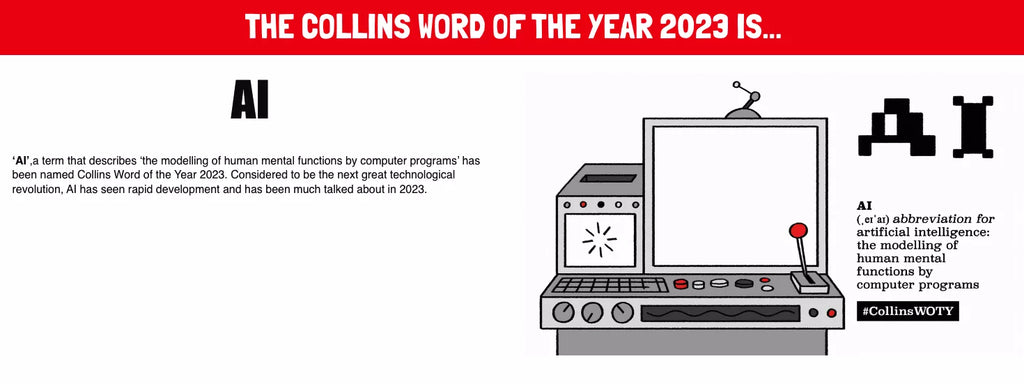
Now, most children and young students prefer specific examples of use over abstract definitions. We've got your back; you can find a whole section dedicated to kid-friendly AI examples below.
But for now, let's say that AI is a tool that can help us find information on the internet, play games with us, or even power self-driving cars. It does that by machine learning.
Engineers create machine learning models, which is like teaching computers to get better at something over time. It's a bit like how your kid gets better at their favorite video game by practicing.
These models learn from lots of information. For instance, if you want a computer to "recognize" cats and dogs, you train it by showing it loads of photos.

The computer then looks at these images, studies them carefully, and starts to notice little clues. It might learn that cats usually have pointy ears and dogs have floppy ones, or that cats often have whiskers and dogs have big, wet noses.
The more pictures the computer sees, the better it becomes at telling who's a cat and who's a dog.
While recognizing cats from dogs may sound like a straightforward task, AI can do much bigger and more complex challenges.
We're not talking just about improving the efficiency in grown-up endeavors like healthcare or finance. If used thoughtfully, artificial intelligence can be a fantastic educational tool for young learners in school, applied to subjects from arts to coding classes.
How can artificial intelligence help your kids & why is it beneficial for them?
For starters, AI can help your child unleash their inner artist. But, "How could AI be beneficial when it does all the work instead of kids?", you might ask.
It's all about how you use AI.
Imagine your kid writing a fantastic story. Then, they could use QuillBot, one of the most popular AI tools, to check their grammar. Lastly, they could use an image generator to complement their story with stunning visuals.
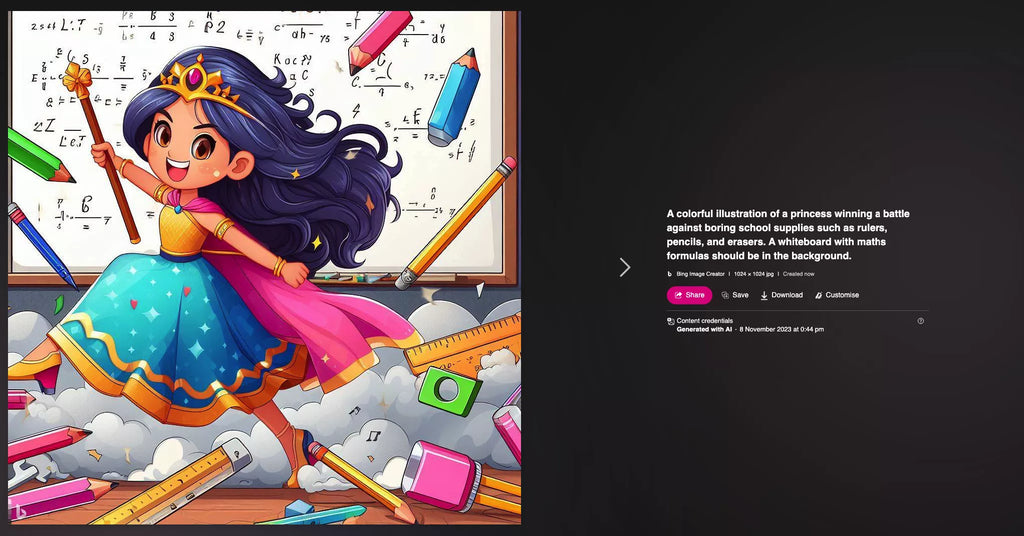
In this creative collaboration, your child remains the mastermind. They decide what to write and how to write it. AI only adds a touch of polish.
Activities like this one are excellent for middle school or high school students who need a little additional motivation to explore their talents.
Next, tinkering with AI-powered gadgets, kits, or apps can foster STEM skills, which are crucial for today's students.
For example, your child can build and program their own AI-powered robot using a DIY kit. Such a hands-on activity shows them how AI can be applied to real-life situations.
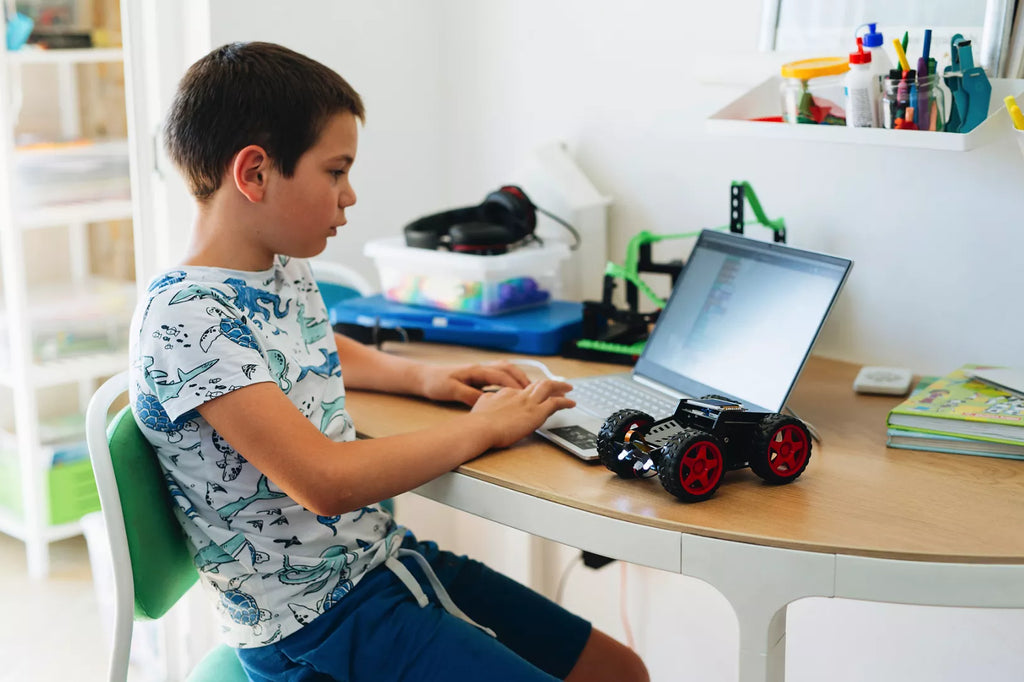
Of course, coding a robot is no small feat—it requires kids to use their problem-solving and critical-thinking skills. Even programming in Scratch or other kid-friendly coding languages can challenge them to think logically, creatively, and systematically.
In the same manner, exploring AI-related projects and coding also turns mathematics into a practical, engaging adventure. Young students can discover that math is not just about numbers and equations on a page but a powerful tool to unlock the secrets of the latest technology.
There are also AI reading tools, like www.luca.ai, that help your kids improve reading skills and take personalized reading to the next level by analyzing your child's interests, creating custom stories, and making reading more interesting and engaging.
When you consider these benefits and their interaction, you'll find that when kids start learning about AI, they're not only gaining valuable new skills. They're also boosting their career potential for the future!
Easy examples for explaining AI to your kids
Now you know the theory, but let's not forget about the kids. At an early age, children prefer learning about the world through tangible examples.
Rather than diving into complex theories, it's better to explain AI in a simple and fun way, using examples they can relate to, like the ones listed below.
Voice assistants
Siri, Alexa, or any other assistants that your kid has on their smart devices all work in a similar way. They use artificial intelligence to understand and respond to voice commands.

More precisely, Siri records frequencies and sound waves from a voice and translates them into code. The code is then broken down to identify particular patterns and keywords.
That's how your voice assistant can chat with you, play your songs, and answer your questions.
YouTube and Spotify recommendations
Have you ever noticed that when you watch YouTube videos, the platform suggests more videos you might like? Or when you're listening to music on Spotify, it magically knows just the right song to play next?
Whether you're into unboxing videos or DIY experiments such as the egg-drop challenge, AI recommendation systems have got you covered. They use your past choices to guess what you might enjoy next.
Face filters and effects
Next time your kid is playing around with quirky filters that turn their face into a scuba diver, tell them they have AI to thank for the fun.

Filters and effects use computer vision and face recognition, which are areas of machine learning.
When you open a face filter app, it uses machine learning to quickly learn what your face looks like. It has seen lots of faces before, so it knows where your eyes, nose, and mouth should be. This way, it can apply the filters or effects you choose in real time.
How to teach your kids about computer science and AI?
Now you're armed with explanations and examples, and it's time for your kid to explore computer science and AI in a hands-on way.
Note that building real AI models is not as easy as showing cat and dog pics to a computer. The machine learning processes involve large amounts of data science, coding, and using specialized tools.
However, there are ways to learn how AI works suitable for students and kids of different ages. Let's see what they are.
Method #1: Educational apps & games
There are plenty of quality online resources that help kids learn how to code and understand the basics of artificial intelligence and data science through engaging apps. These apps often come in a user-friendly, gamified format, making the learning process more fun and interactive.
One such tool is called Quick, Draw!, developed by Google.
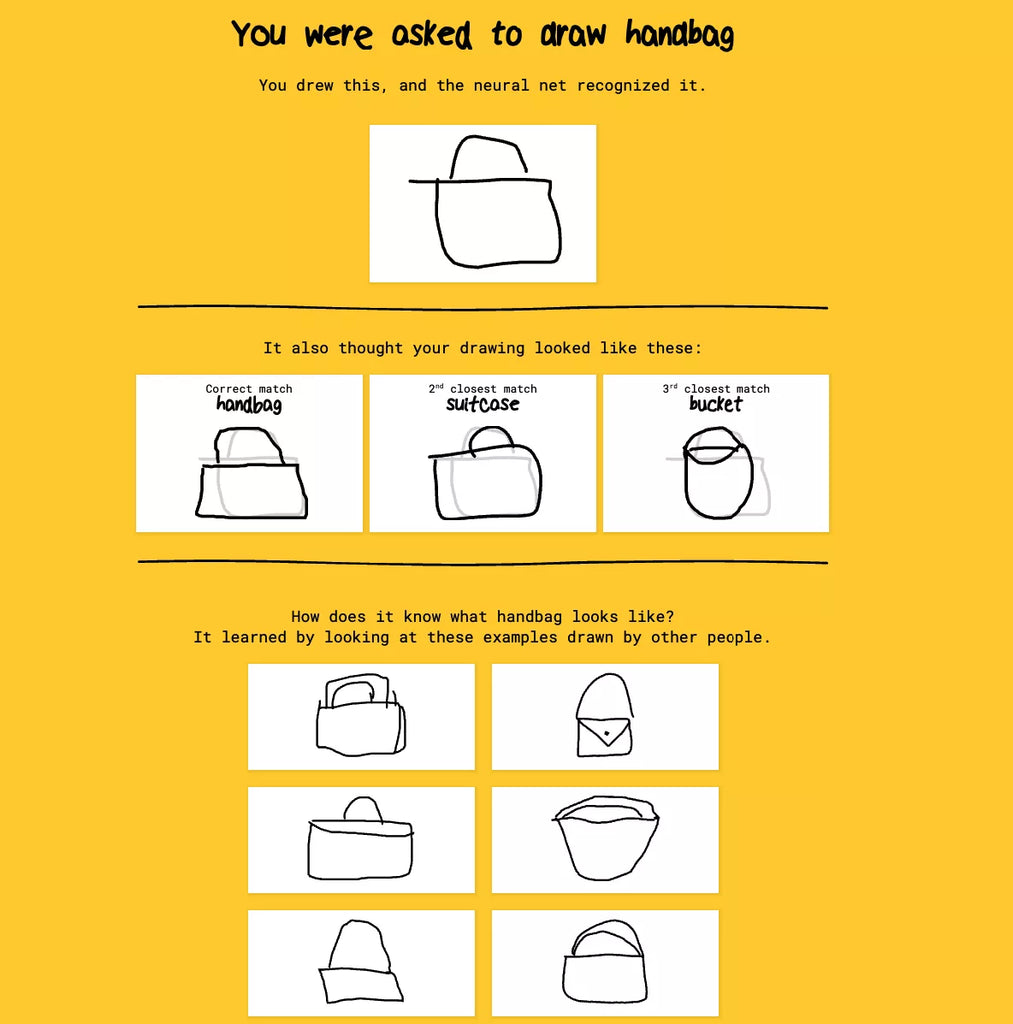
The program asks you to draw an image. A neural network then tries to guess what you've drawn based on thousands of previous attempts from other people.
This can give kids insight into how AI algorithms learn from data and improve their accuracy over time. It's a great way for kids to understand that AI isn't just about doing tasks but also about learning from experiences.
Ambitious students looking for more advanced resources can check out another web-based tool developed by Google, called Teachable Machine.

If you want to train AI, you have to provide images or sounds, depending on your project. These can be hard to get by. Luckily, Teachable Machine lets you quickly create your own machine learning models.
That way, you can teach computers to recognize your images, sounds, and poses, and use them to build games or apps.
Method #2: STEM kits
All right, now this is where things get more engaging. A virtual approach to artificial intelligence may be fun, but do you know what kids love even more?
It's holding something they've created in their hands and watching it come to life.
With STEM kits that incorporate AI, your kids can do just that. Remember how we mentioned Siri and Alexa as prime examples of AI usage?
Well, there's an exciting STEM kit available that lets your kids create their very own DIY voice assistant, Spencer.
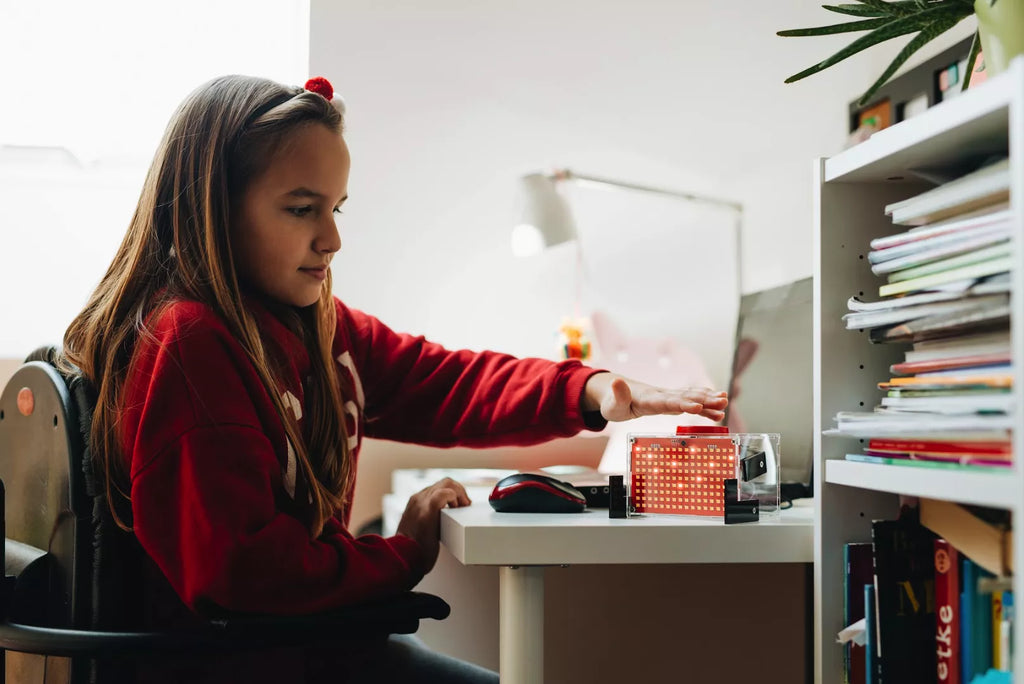
After assembling the assistant, your kid gets to code it, and ask it question after question. From the standard "What's the weather?" to "Tell me a joke!", Spencer knows it all and looks way cuter than your average voice assistant.
By exploring this STEM kit, kids learn about the Internet of Things, AI, voice recognition, and speech synthesis.
Depending on your child's skills and interests, you can find different varieties of STEM kits, each of which opens a world of possibilities to interact with AI.
Method #3: AI Classes
If you think your child is ready to explore AI on a more structured level, AI classes are an excellent choice. They are designed to provide in-depth knowledge and practical skills related to artificial intelligence.
For instance, Udemy classes like this one teach children how to create and code AI models using Scratch. Over the course, students code several smaller AI projects. The final project involves developing an AI chatbot!
There are also classes designed for children with less coding experience.
This Outschool class, for example, uses Scratch and guides students while they train a Pac-Man that avoids the ghost on its own.
Regardless of your child's coding background, there are AI classes available to match their knowledge level.
Method #4: AI-related books and videos
Of course, some children prefer studying the theory before diving into projects. If that's the case with your little one, you could suggest exploring resources such as books and videos about artificial intelligence.
The choice of media is up to you because there are so many subcategories of the field.
Is your child interested in the ethical aspect of artificial intelligence? The technical aspect, perhaps? Or do they want to be guided through specific projects?
Depending on the answer, you can find helpful books and videos that cater to your kid's particular interests.
Method #5: Coding projects
Lastly, once your kid has grasped the foundations, it's time to move to coding projects. These projects encourage children to put their coding skills to the test while exploring AI concepts in a practical manner.
Your kid can start with small, simple projects and gradually work their way up to more complex challenges as their coding abilities improve. This progression allows them to learn at their own pace and steadily build their AI skills.
Here are a few coding project ideas to consider:
- Simple gesture-controlled video games (think Flappy-Bird-level simple)
- Dish classifier
- Toy recognizer
- Face filters
- Handwriting recognition app
By developing such programs, your child can apply their creativity, problem-solving skills, and decision-making ability while gaining a deeper understanding of AI.
So, let their skills grow, one line of code at a time.
Teach kids about AI and machine learning models with exciting CircuitMess kits
Although it's hard to beat human intelligence, artificial intelligence is here to stay, so it's good to prepare kids for the future.
Your kid may not be ready to build real self-driving cars just yet, but they certainly can start working on simpler projects with the help of carefully designed classes or STEM kits. At CircuitMess, we're passionate about empowering children for the technologies of the future, and a number of our STEM kits explore AI.
Your kid can build and program robots, make them perform tasks, and learn AI-related skills, all while having fun.
So, pick a kit, and watch your future tech innovator evolve!
Read stories how our founder Albert turned his childhood passion into CircuitMess, and get exciting DIY project ideas you can do with your kids at home for free.
Read more

What is STEM? A Fun and Future-Focused Way to Learn
The future demands adaptable and innovative minds. This guide breaks d...

Is Your Child Ready to Become a Space Explorer? (Here's How)
Your portal to space exploration. Build robots, code games, and unlock...

DIY Delights: 5 Easy Electronics Projects for Kids
Join thousands of parents inspiring their kids with these 5 easy elect...
